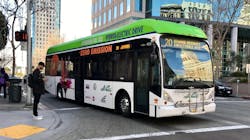California plans to go fully electric with its bus fleets in the next 22 years
California transit agencies have until 2040 to go all electric with buses following the California Air Resources Board’s (CARB) approval of a regulation Dec. 14, which sets a statewide goal for public transit agencies to gradually transition to 100-percent zero-emission bus fleets.
CARB explains that the transportation sector accounts for 40 percent of the state’s gas emissions and 80-90 percent of smog-forming pollutants. The board says that the Innovative Clean Transit regulation and the transition to zero-emission technologies, where feasible, is essential to meeting California’s air quality and climate goals.
“A zero-emission public bus fleet means cleaner air for all of us. It dramatically reduces tailpipe pollution from buses in low-income communities and provides multiple benefits especially for transit-dependent riders,” CARB Chair Mary D. Nichols said. “Putting more zero-emission buses on our roads will also reduce energy consumption and greenhouse gases and provides cost savings for transit agencies in the long run.”
CARB notes that public transit agencies operate about 12,000 buses throughout the state of which 153 are zero-emission. The number of zero-emission buses is expected to increase to 1,000 by 2020 based on the number of buses either on order or planned for purchase.
To successfully transition to an all zero-emission bus fleet by 2040, each transit agency will submit a rollout plan under the regulation demonstrating how it plans to purchase clean buses, build out necessary infrastructure and train the required workforce. The rollout plans are due in 2020 for large transit agencies and in 2023 for small agencies. Agencies will then follow a phased schedule from 2023 until 2029, by which date 100 percent of annual new bus purchases will be zero-emission. To encourage early action, the zero-emission purchase requirement would not start until 2025 if a minimum number of zero-emission bus purchases are made by the end of 2021.
Greenhouse gas emissions are expected to be reduced by 19 million metric tons between 2020 to 2050 following full implementation of the regulation. CARB says this is the equivalent to removing 4 million cars from the road. Tailpipe emissions (nitrogen oxides and particulate matter) will also be reduced by about 7,000 tons and 40 tons respectively during that same 30-year period.
Additionally, transit agencies are expected to save an estimated save $1.5 billion in maintenance, fuel and other costs by 2050 after the full buildout of infrastructure.
CARB says transit agencies are well-suited for introducing these technologies and believes these agencies play a pivotal role in transitioning vehicle fleets to zero-emission alternatives.
Electrifying the heavy-duty transportation sector is supported by a range of government policies and programs. Public funding for zero-emission vehicles and related charging infrastructure is administered by CARB, the California State Transportation Agency, Caltrans, the California Energy Commission and local agencies.
In addition, utilities are supporting this transition with new electricity rate designs and investments in charging infrastructure. The Department of General Services is also streamlining bus purchases through a single statewide zero-emission bus purchase contract.
BYD Motors LLC, a developer of battery-electric technology and electric bus manufacturer, applauded CARB’s adoption of the Innovative Clean Transit regulation.
“We stand ready to deliver and make the transition to zero emission buses a reality,” said BYD President Stella Li.
BYD says it has also partnered with Generate Capital on a leasing program for its equipment to accelerate the transition to zero-emission buses. But also noted that that state should continue to provide funding incentives to “reduce or eliminate upfront incremental costs of zero emission buses and corresponding infrastructure.”
BYD says the financing available through programs such as the Hybrid and Zero-Emission Truck and Bus Voucher Incentive Program, Low Carbon Transit Operation Program, Transit and Intercity Rail Capital Program, utility investments and other programs is “absolutely vital to ensuring transit agencies can comply with this regulation and help the state meet its ambitious air quality goals.”
About the Author

Mischa Wanek-Libman
Group Editorial Director
Mischa Wanek-Libman is director of communications with Transdev North America. She has more than 20 years of experience working in the transportation industry covering construction projects, engineering challenges, transit and rail operations and best practices.
Wanek-Libman has held top editorial positions at freight rail and public transportation business-to-business publications including as editor-in-chief and editorial director of Mass Transit from 2018-2024. She has been recognized for editorial excellence through her individual work, as well as for collaborative content.
She is an active member of the American Public Transportation Association's Marketing and Communications Committee and served 14 years as a Board Observer on the National Railroad Construction and Maintenance Association (NRC) Board of Directors.
She is a graduate of Drake University in Des Moines, Iowa, where she earned a Bachelor of Arts degree in Journalism and Mass Communication.
